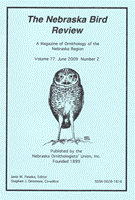Nebraska Ornithologists' Union

Nebraska Bird Review
Date of this Version
9-1987
Document Type
Article
Citation
“Notes,” from Nebraska Bird Review (September 1987) 55(3).
Abstract
FUNK LAGOON. We were at the Funk Lagoon 2 July 1987, toward dusk. We saw two Yellow-crowned Night-Herons, five American Bitterns, two Great Egrets, thirty Great Blue Herons, five Double-crested Cormorants, numerous Coots, Blue-winged Teal, Yellow-headed and Red-winged Blackbirds, Killdeer, a flock of Short-billed Dowitchers, and several unidentified shore birds.—George W. Brown, Kearney
WOOD DUCK CARRYING EGG. On 24 April 1987, Gail Roebuck was hiking along the north Stream Trail in Fontenelle Forest and heard Wood Duck calls. She looked up to see the female carrying something in her bill. The Duck dropped the object along the edge of the trail, and Gail went over to investigate. The 20-foot fall hadn’t even broken the egg Gail found.—Ruth C. Green, Bellevue
MORE ON THE DESOTO EIDERS. The summer 1987 issue of Iowa Bird. Life (57:88) has about a page and a half of comments, four photographs , and four drawings of the eiders seen at DeSoto last winter (NBR 54: 10 and 81). The Iowa records committee accepted them both as King Eiders.
SWAINSON’S HAWKS. On 28 September 1986 we were traveling east on a gravel road 3 miles south and 2 miles west of Coleridge, Cedar County. In a 28-minute period from 4:48 to 5:14 PM we observed a total of 166 Swainson’s Hawks flying out of the north-northwest into the south-southeast.—Dave and. Lois Stage, Laurel
PRAIRIE GROUSE. Over the weekend of 11 and l2 April 1987 Bill Huser, Jerry Probst, and I traveled to Center, Nebraska, to observe Sharp-tailed Grouse (Tympanuchus phasianellus) and Greater Prairie-Chickens (T'ympanuchus cupido) which were reported to be in the area.—Randall D. Williams, Sioux City, Iowa
WHOOPING CRANE REPORT. The Fish and Wildlife Service office in Grand Island has released the record of Whooping Crane sightings in Nebraska in the spring of 1987.
WINTERING KILLDEER. On 17 January 1987 John Manning and I saw a hardy, healthy Killdeer in a pasture that had a spring-fed pond and open water.—Duane Wolff, Norfolk
CRESCENT LAKE NESTING RECORDS. The first known production of White-faced Ibis on Crescent Lake NWR was recorded in 1987 with not one but two successful nests discovered on Smith Lake. Refuge personnel documented and photographed a total of seven young.—Royce R. Huber, Refuge Manager, Ellsworth
BLAIR BACKYARD BIRDING. On 22 August 1987 my father spotted a Ruby-throated Hummingbird in our backyard, and soon after that I saw two Wilson’s Warblers. Later on I saw another warbler, bluish-gray above and yellow below, prominent eye-ring, a hint of a band across the breast, and yellow feet, so I decided it was a Canada Warbler. And later the same day I saw about twenty Empidonax flycatchers and four more Wilson’s Warblers. And a week later we had a small warbler in our bird bath. The bird had very prominent wingbars, yellow below, light brown above, and when it flew it had white on the outside and around the tail like a Vesper Sparrow. We figured it to be a Pine Warbler.—Joel Jorgensen, Blair
BLUEBIRD NEST BOXES. In 1985, Boy Scout Troop 18 of Gering made 150 bluebird nesting boxes as a conservation project and in honor of scouting’s 75th anniversary. In the early spring the Boy Scouts, along with members of the Wildcat Audubon Society, placed 115 of these nesting boxes in the Wildcat Hills south of Gering as a Mountain Bluebird trail.—Alice Kenitz, Gering
LEWIS’ WOODPECKER DOESN'T QUALIFY. The Bill Lemburgs saw a Lewis’ Woodpecker from US 83, within the Waterfowl Refuge, on their way home from the 1987 Annual Meeting. It was just a little after noon, and so outside the official count period.
ONE OF OUR COWBIRDS IS MISSING. All winter long three Cowbirds, one male and two females, were staying in my one feedlot. On cold days they would huddle on the back of a fat heifer. The cow and birds both looked content. Then on 20 January 1987 a Cooper’s Hawk showed up, slowly moving over and around the cattle. Since then only the male and one female are around.—Duane Wolff, Norfolk


Comments
Copyright 1987 Nebraska Ornithologists’ Union. Used by permission.